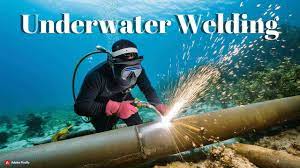
Introduction
Underwater welding, also known as wet welding, is the process of joining metals underwater using specialized techniques and equipment. It plays a vital role in marine construction, maintenance, and repair, particularly for offshore oil and gas platforms, ships, pipelines, and underwater infrastructure. Given the complexities of working underwater, this profession requires highly skilled divers trained in both welding and diving safety.
Types of Underwater Welding
-
Wet Welding:
In wet welding, the welder operates directly in the water with a waterproof electrode. The weld takes place in the water environment, exposing the process to moisture, pressure, and other hazards. Wet welding is quicker and more flexible but has limitations in weld quality and strength due to rapid cooling and hydrogen embrittlement risks. -
Dry Welding (Hyperbaric Welding):
Dry welding occurs inside a sealed chamber filled with gas (usually air or a mix), isolating the weld area from water. This method produces higher quality welds, similar to those done in air, and is commonly used in critical applications but requires complex setup and equipment.
Equipment and Techniques
-
Diving Gear: Underwater welders use scuba or surface-supplied diving equipment, often combined with helmets designed to accommodate communication and protect from sparks.
-
Welding Power Sources: Typically, direct current (DC) welding machines are preferred underwater to minimize electrical hazards.
-
Electrodes: Special waterproof electrodes with coatings that stabilize the arc underwater are used.
-
Safety Measures: Constant communication, buddy systems, and emergency protocols are critical due to the hazardous working environment.
Applications
-
Repairing ship hulls and offshore platforms damaged by corrosion or accidents.
-
Constructing subsea pipelines and infrastructure for oil and gas extraction.
-
Maintenance of underwater tunnels, dams, and bridge supports.
-
Salvage operations where cutting and welding underwater are necessary.
Challenges and Risks
Underwater welding is one of the most dangerous jobs due to factors such as:
-
Risk of electric shock.
-
Decompression sickness from diving.
-
Exposure to toxic gases and underwater currents.
-
Reduced visibility and cold temperatures.
-
Health risks related to prolonged exposure to wet conditions and welding fumes.
Future of Underwater Welding
Advancements in robotics and remotely operated vehicles (ROVs) are beginning to supplement human welders in hazardous or deepwater environments. However, human skill remains essential for complex tasks requiring judgment and adaptability. Training and safety technology continue to improve, making underwater welding safer and more efficient.
Conclusion
Underwater welding is a challenging yet indispensable profession supporting marine industries and underwater infrastructure. With ongoing technological advances and rigorous safety practices, underwater welding will continue to evolve, enabling safer and more effective repairs and construction beneath the waves.

You must be logged in to post a comment.